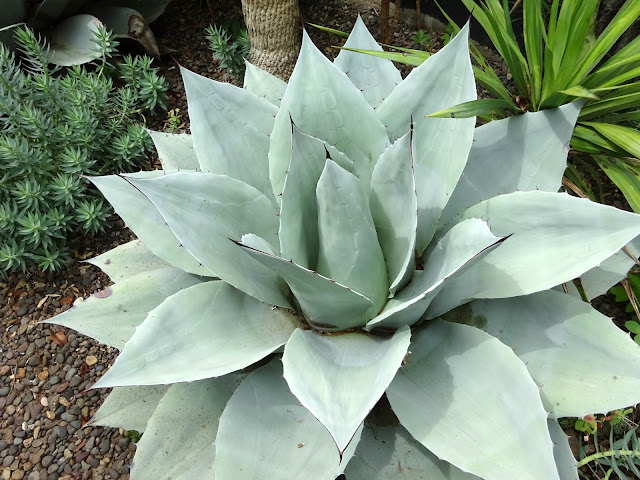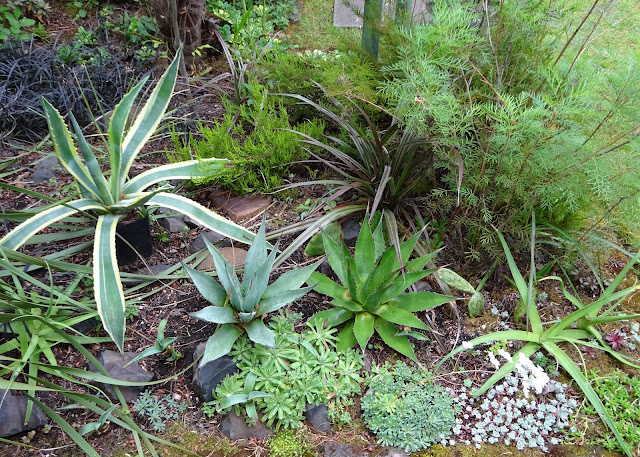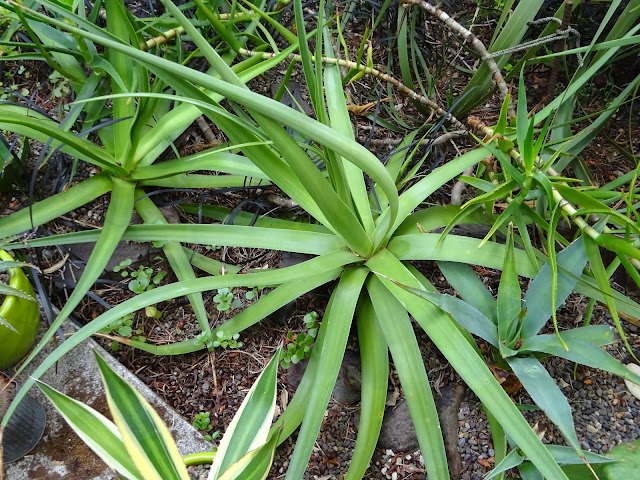What a winter it was for agave lovers gardening in Portland. Over the past few months I've written so much about the agaves that didn't make it, some of you were probably wondering if I had any agaves left in my garden. Yes. The answer is definitely yes—and I've added even more over the last few weeks, but that's a post for another day. Today we look at my agaves that made it through last winter, photos taken on June 14th.
We start at the front of the house, next to the driveway. This NOID (from a Cistus tough love sale), along with the small Agave parryi, got absolutely no protection.
The bloom belongs to an Aloe (Aristaloe) aristata. These two agaves got a layer of frost cloth and a piece of reflective "bubble foil" insulation laid over them during
the December storm, nothing for
the February event.
Agave 'Streaker' (a gift plant from Sean Hogan/Cistus Nursery)
Agave 'Baccarat'
To the left of the front steps. The in ground agaves here were protected during the December storm, but nothing thereafter.
Agave 'Baccarat' (center) and Agave americana var. protoamericana (on the right), on the left Agave parryi 'Notorious RBG' (ignore the agave in the container as it was pulled undercover for the winter).
Agave parryi 'Notorious RBG' (my name for a NOID purchased at the Ruth Bancroft garden) close-up.
Agave parryi from Bryon Jones (Pt Defiance Zoo & Aquarium).
This Agave montana was protected during the first round of winter extremes (December) but not the second in February.
I guess I should come up with a code to use from here on out. P1 is December protection, PA is all winter, as there are a few things out back that spent the whole winter covered. NP means there was never any winter protection.
Agave 'Mateo' (P1)
Here's my pair of Agave ovatifolia 'Frosty Blue'. These both went in the ground in the spring of 2013 and were just small gallon-sized plants
back then (P1).
The one in the foreground, closest to the front steps has been struggling all winter. Thankfully the warm dry May and early June has really helped it.
The worst spot now...
And back on May 22nd...
If this summer is hot and I remember to give it plenty of water it should put on a lot of new growth and maybe push through the wounds? Time will tell.
Here's the second one, which was always kind of the less glamorous of the twins. Not anymore...
Looking south along the front of our house, this is the first time Alberta (Yucca rostrata in the foreground) and Holman (Yr in the background) have appeared together here on the blog.
Huh, I guess I couldn't decide which photo to upload.
Okay, moving on. I'm still stunned this small variegated Agave parryi made it through the winter, P1.
Another Agave ovatifolia (P1)
I've always thought this blue agave to the left of the Yucca rostrata was an Agave 'Silver Surfer', but I'm beginning to wonder if it isn't an Agave parryi? (P1)
Agave bracteosa (NP)
Agave parryi 'JC Raulston' (P1)
Three more Agave parryi 'JC Raulston' (P1), and on the far right is...
An abused Agave ovatifolia (NP), but it's alive!
The last photo from the front garden, Agave parryi 'JC Raulston' (P1) with an Agave ovatifolia (NP) in the background.
This Agave americana is in the driveway is (P1). It needs to be planted out or root pruned, the poor thing has been in this container for too long.
The variegated Agave americana on the far left has since been planted in the ground—a summer fling—but of course it didn't spend winter in this location, the rest did though (PA). Close-ups follow from left to right.
Agave bracteosa (PA)
Agave neomexicana (maybe ?), on the left (PA) and Agave montana on the right (PA)
Agave bracteosa (PA)
There was a long plastic-covered tunnel over this entire in-ground planting all winter, so they're PA.
Looking at those plants close up, there are a couple of small agaves I no longer can ID, and then an Agave bracteosa and an Agave 'Mateo'.
The Agave 'Mateo' with a small A. montana in front of it—as well as a blooming Aloe striatula (aka Aloiampelos striatula).
This agave came from a rescue operation (
here), I think it's an Agave salmiana.
Another perspective on the area...
Just a couple more now, another Agave bracteosa (PA)...
And this containerized Agave ovatifolia 'Frosty Blue' (PA). What's that? You don't see a container?
There it is. I'm guessing the roots have grown down through the drainage hole.
That's a wrap! While it was an extremely ugly winter for my garden, and agaves in particular, I feel great about what did survive and they're now enjoying another beautiful PNW summer!
All material © 2009-2023 by Loree L Bohl. Unauthorized reproduction prohibited and just plain rude.









































Glad that they're recovering.
ReplyDeleteHow bad was it this winter? What was the lowest temperature during the first storm? How much snow? I'm asking because what you consider a bad winter may be a normal winter in other areas.
This is the same "Anonymous." I checked weather data. Coldest was Dec 22 and 23 with 17 degrees and 16 degrees respectively, with highs of 24 and 28 deg. both days. Then Feb 23, 24, 25 with lows of 24, 23 and 20 deg.
DeleteYes, that sounds about right, thanks for looking up the info. What those stats don't take into account though is the nasty harsh wind during the December event. When it's below freezing for 72 hours and the strong wind and low humidity are zapping all the moisture and there is no snow cover and ice falls... well, it was rather damaging. The lows in February came with unexpected amounts of snow, and ice. The most important point I would like to address though is your comment "I'm asking because what you consider a bad winter may be a normal winter in other areas". You're right, I shouldn't have assumed that everyone reading this post was following along during those earlier events, or that if they were they would have remembered the specifics. However I also need to point out that all gardening is local, we plant for our climate. So while those temperatures and conditions would be mild for someone gardening in Zone 5, they caused a lot of damage in gardens here.
DeleteYour survivors look pretty darn good. And some new ones? Looking forward to seeing what. :)
ReplyDeleteI need to get out there and take some pictures!
DeleteI'm amazed at how good they all look. You've had some seriously miserable weather. I think you've also armed yourself with good materials to cover things etc. I am usually just using old sheets and blankets or pulling plastic bags over things.
ReplyDeleteIndeed, I've got a great stash of materials. Not that I always use them, our winter events can sometimes happen without warning.
DeleteYou did pretty well all things considered, Loree. I hope the spotted specimens continue to recover as the summer proceeds.
ReplyDeleteThanks Kris!
DeleteHooray for healthy agaves! You have, to my eyes, a fabulous collection still. I learned about watering agaves in summer to speed growth from Preston (Cistus) recently, good to know. I have a feeling they'll all pull through. Looking good, Loree.
ReplyDeleteYep, we have to give them the monsoon moisture they're missing!
DeleteLosses are to be expected every winter but you had more than your fair share. It's nice to see the many that did survive and are looking pretty darn good to boot. Might help you decide who needs a bit of help through the winter.
ReplyDeleteWinter seems so far away now...
DeleteAgave parryi takes cold, rain, snow here in northern Arizona and I am happy it makes it there too. You have lots of great ones that made it though, thank goodness!
ReplyDeleteMost Agave parryi do not do well here, only 'JC Raulston' is reliable, well, except for Notorius RBG and the one from my friend Bryon...
DeleteSo glad to see that most of your agaves made it. I lost a large variegated ovatifolia and a nice-sized nickelsiae to rot.
ReplyDelete'Silver Surfer': As you said, I don't think it's that. It would be much bigger by now.
Looking forward to meeting your new agaves!
They'd love to meet you in person...
DeleteTrying JC Raulston again in another gravelly spot. Planted it at an angle. It’s got a long, warm summer ahead to establish. Hoping your A. ovatifolia recover quickly.
ReplyDelete